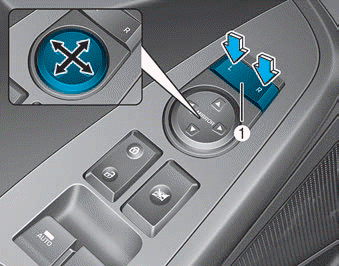Hyundai Ioniq: Towing / Emergency Towing

■ Front

■ Rear
If towing is necessary, we recommend you to have it done by an authorized HYUNDAI dealer or a commercial tow truck service.
If a towing service is not available in an emergency, your vehicle may be temporarily towed using a cable or chain secured to the emergency towing hook at the rear of the vehicle.
Use extreme caution when towing the vehicle with a cable or chain. A driver must be in the vehicle to steer it and operate the brakes.
Towing should be done only on a solid ground for a short distance and at a low speed.
Also, the wheels, axles, power train, steering and brakes must all be in good condition.
Always follow these emergency towing precautions:
- Place the Engine Start/Stop button in the ACC position so the steering wheel is not locked.
- Place the shift lever in N (Neutral).
- Release the parking brake.
- Depress the brake pedal with more force than normal since you will have reduced braking performance.
- More steering effort will be required because the power steering system will be disabled.
- Use a vehicle heavier than your own to tow your vehicle.
- The drivers of both vehicles should communicate with each other frequently.
- Before emergency towing, check that the hook is not broken or damaged.
- Fasten the towing cable or chain securely to the hook.
- Do not jerk the hook. Apply steady and even force.

- Use a towing cable or chain less than 16 feet (5 m) long. Attach a white or red cloth (about 12 inches (30 cm) wide) in the middle of the cable or chain for easy visibility.
- Drive carefully so the towing cable or chain remains tight during towing.
- Before towing, check the dual clutch transmission for fluid leaks under your vehicle. If the dual clutch transmission fluid is leaking, flatbed equipment or a towing dolly must be used.
CAUTION
To avoid damage to your vehicle and vehicle components when towing:
- Always pull straight ahead when using the towing hooks. Do not pull from the side or at a vertical angle.
- Do not use the towing hooks to pull a vehicle out of mud, sand or other conditions from which the vehicle cannot be driven out under its own power.
- Limit the vehicle speed to 10 mph (15 km/h) and drive less than 1 mile (1.5 km) when towing to avoid serious damage to the dual clutch transmission.
 Removable Towing Hook
Removable Towing Hook
1. Open the liftgate, and take the towing hooks out from the tool case.
■ Front
■ Rear
2. Remove the hole cover by pressing the lower part of the cover on the front
or rear bumper...
 If an Accident Occurs
If an Accident Occurs
WARNING
For your safety, do not touch high voltage cables, connectors and package
modules. High voltage components are orange in color.
Exposed cables or wires may be visible inside or outside of the vehicle...
Other information:
Hyundai Ioniq (AE) 2017-2025 Service Manual: Repair procedures
Removal • Be sure to read and follow the "General Safety Information and Caution" before doing any work related with the high voltage system. Failure to follow the safety instructions may result in serious electrical injuries...
Hyundai Ioniq (AE) 2017-2025 Service Manual: Front Bumper Cover. Components and components location
C..
Categories
- Manuals Home
- 1st Generation Ioniq Owners Manual
- 1st Generation Ioniq Service Manual
- Child-Protector Rear Door Locks
- Washer Fluid
- Immobilizer System
- New on site
- Most important about car
Side view mirror control

Adjusting the side mirrors:
1. Press either the L (driver's side) or R (passenger's side) button (1) to select the side view mirror you would like to adjust.
